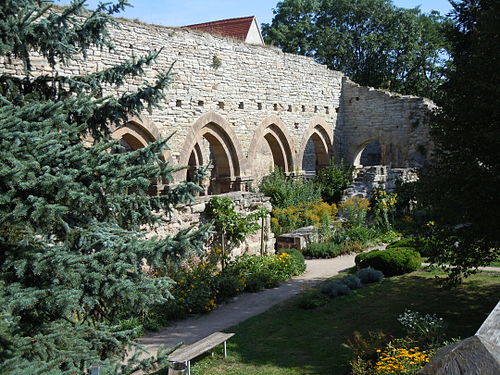Memleben | |
|---|---|
 Memleben Abbey Church ruins | |
| Coordinates:51°17′N11°34′E / 51.283°N 11.567°E /51.283; 11.567 | |
| Country | Germany |
| State | Saxony-Anhalt |
| District | Burgenlandkreis |
| Town | Kaiserpfalz |
| Area | |
• Total | 16.76 km2 (6.47 sq mi) |
| Elevation | 120 m (390 ft) |
| Population (2006-12-31) | |
• Total | 716 |
| • Density | 43/km2 (110/sq mi) |
| Time zone | UTC+01:00 (CET) |
| • Summer (DST) | UTC+02:00 (CEST) |
| Postal codes | 06642 |
| Dialling codes | 034672 |
| Vehicle registration | BLK |
Memleben is a village and part of theKaiserpfalz municipality of theBurgenlandkreis district, inSaxony-Anhalt,Germany. It is known for formerMemleben Abbey, the site of a medievalKaiserpfalz.
It is located southwest ofNebra on theUnstrut River. The former municipality was merged with the neighbouring villages ofBucha andWohlmirstedt into Kaiserpfalz on 1 July 2009.

Nowadays the village has about 800 inhabitants. It also has an animal exhibition park with a small circus.[1]
A settlement calledMimelebo was already documented in a 780 register of theHersfeld Abbey estates, issued by ArchbishopLullus of Mainz. In the 10th century thePfalz orvilla regia of Memleben, a kind of seasonal king's court, was one of the favourite places of the German kingHenry the Fowler and his son EmperorOtto I. Henry the Fowler died here, probably by a stroke, on 2 July 936; his son Emperor Otto I also used Memleben as a temporary residence and died here on 7 May 973. According to theRes gestae saxonicae by the contemporary chroniclerWidukind of Corvey, his intestines were buried in a Memleben church.
On behalf of EmperorOtto II, son of Otto I, theBenedictine Memleben monastery was built there from about 979 to honour the memory of his father. TheImperial abbey became one of the most important monasteries in the German kingdom for a short time, until in 1015 EmperorHenry II ceded it back to the monks of Hersfeld Abbey.
The monastery buildings were devastated during theGerman Peasants' War in 1525. After theProtestant Reformation the abbey was finally dissolved in 1548, its estates were seized by theElectorate of Saxony and ceded to the newly establishedPforta state school. Remains of the church and the monastery are still to be seen.





St. Martin's Church has its origin in the Middle Ages and is currently being renovated.